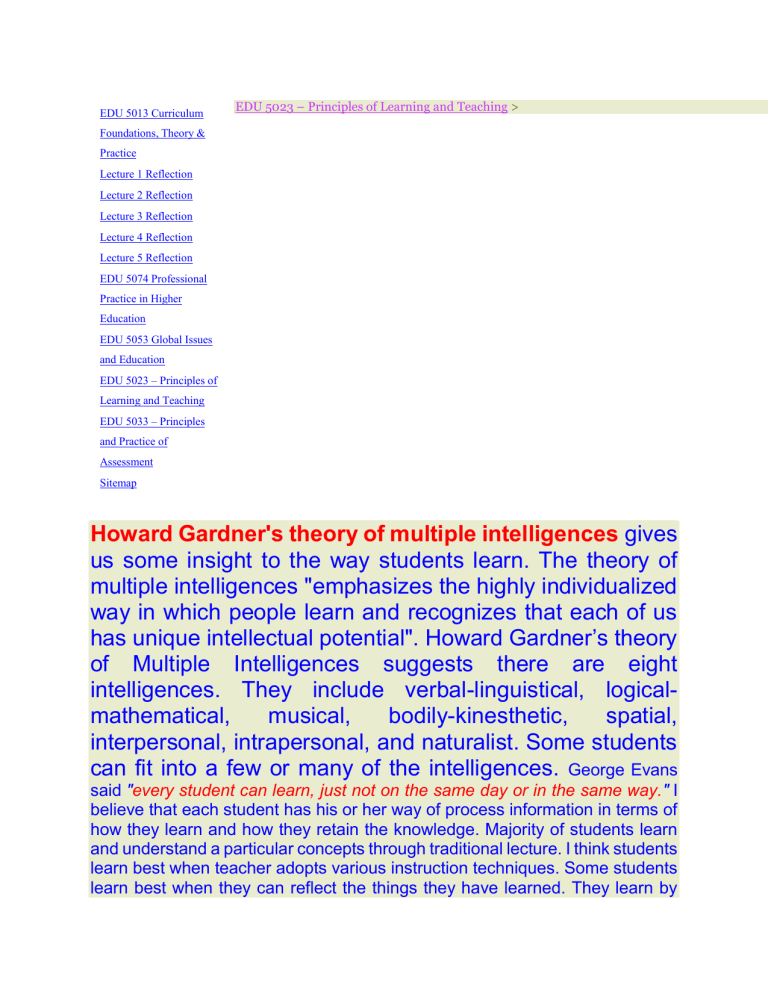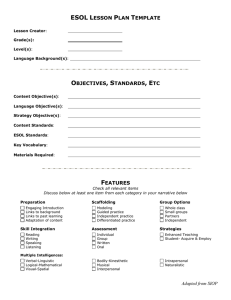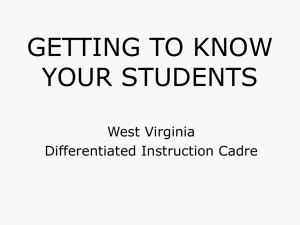
EDU 5013 Curriculum EDU 5023 – Principles of Learning and Teaching > Foundations, Theory & Practice Lecture 1 Reflection Lecture 2 Reflection Lecture 3 Reflection Lecture 4 Reflection Lecture 5 Reflection EDU 5074 Professional Practice in Higher Education EDU 5053 Global Issues and Education EDU 5023 – Principles of Learning and Teaching EDU 5033 – Principles and Practice of Assessment Sitemap Howard Gardner's theory of multiple intelligences gives us some insight to the way students learn. The theory of multiple intelligences "emphasizes the highly individualized way in which people learn and recognizes that each of us has unique intellectual potential". Howard Gardner’s theory of Multiple Intelligences suggests there are eight intelligences. They include verbal-linguistical, logicalmathematical, musical, bodily-kinesthetic, spatial, interpersonal, intrapersonal, and naturalist. Some students can fit into a few or many of the intelligences. George Evans said "every student can learn, just not on the same day or in the same way." I believe that each student has his or her way of process information in terms of how they learn and how they retain the knowledge. Majority of students learn and understand a particular concepts through traditional lecture. I think students learn best when teacher adopts various instruction techniques. Some students learn best when they can reflect the things they have learned. They learn by listening, brainstorming and sharing ideas with others. On the other hand, some students learn best through conceptual learning and logical thinking. Some students need to be actively involved in their own learning by practicing handson problem solving. Every person has strengths and challenges in abilities. No two people are the same. As a result, it is not fair to assume every student will learn best with the same instructional strategy. Each student has unique multipleintelligences and the different ways to learn. In other words, not every person learns best from a single teaching approach. As a teacher, I must constantly be aware of the learning styles of my students in order to incorporate instructional strategies that will enhance their learning potential. At the beginning of a class, it would be useful to give students a quiz that would interpret each student’s favored learning style. A free one that could be used is found at www.edutopia.org/multiple-intelligences-learning-styles-quiz. It gives me a better idea of the learning styles of my students. It also helps me decide the best way to present information and to design activities. I believe it is equally important to include bits of each of the intelligences. Verbal-Linguistic—Verbal/linguistic learners enjoy hearing, seeing, reading, writing, discussing, debating and thinking about words. These are the students who can be relied upon to listen as I speak, watch as I write on the chalkboard, and take notes. These are the most traditional students who our school was designed for. In classroom, I deliver the lesson via e-books, powerpoints and whiteboards. Sometimes, I come into the classroom and just talk for an hour without using any technology except writing on whiteboards. I also record some of my lectures and they can listen it at home. Logical-Mathematical—I teach my students how to recognize and solve quantitative problem in chemistry. Sometimes there are many ways to obtain the final answer. I demonstrate and explain the pros and cons of different ways and strategies to get the answer. For example, some of my students do very well in quantitative part of the chemistry. However, they find problem understanding the theory and explanation part of the chemistry. Visual-spatial— While the verbal/linguistic learners think in words, the spatial/visual learners think in pictures. They are picture smart. They tend to think in pictures and colors and images. They are creative and imaginative. I have administered the learning styles quiz that I mentioned above to my students. Not surprisingly to me, most of them are strongly visual-spatial learners. As a teacher, I like to include some sort of visual such as pictures, graphics, posters, drawings, charts, newspaper clipping, and cartoons in my powerpoint presentation. I have also used video clips that I have found at YouTube. A good picture actually tells a thousand words. Students will understand much deeper when they see a clear picture of the lesson. When teaching about chemical bonding and geometry, the students are stimulated with visual and audio aids using diagrams and video. This helps them to recognize the shapes of molecules. When they can imagine the molecule, they can relate and understand the concept better. For those bodilykinesthetical students, they learn better when they touch and play with the real models in class. Another example is where i show a funny video that explain about chemical bonding. C Musical—Many students feel they have to be “in tune” with the subject. They learn best when more to sounds listen. This type of learner can easily understand patterns and relationships in the songs or rhythms. They enjoy listening to music and sounds. As a teacher, I think using sound in classroom can caught the students’ attention. I have a number of students who tell me that they can read or study better while listening to music. Sometimes, I find ways to introduce music into the classroom. For example, I use sodium chloride song to explain about the chemical reaction between sodium and chlorine to form sodium chloride salt. Sometimes when the students cannot recall certain concepts, I sing the song to my students to help them recollect the information. I also introduce some sounds when playing some animation that describe about certain concepts. NaCl song Bodily-Kinesthetic—These students enjoy touching things and moving around. As a teacher it would be important to give students a chance to stand up and move around. I ask my students to write the working steps on whiteboard. In laboratory, they practice exploration and hands-on experiment. Taking a walk outside or going on a field trip would be helpful. With technology there are virtual field trips available. The interactive sites give students that sense that they are moving around, even if they are not, by just moving a mouse. When assigning project to student, I allow the students to choose ways to present it, either in powerpoint, role play, demonstration, or film. Interpersonal and intrapersonal—I assign my students in group and give them problem-solving task. This encourages my students to discuss with others and sharing some ideas.I also gives individual assignment to my students to discuss about certain topic, where i ask them to reflect about the things they have been learned.


